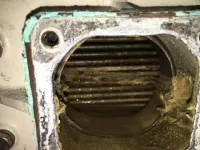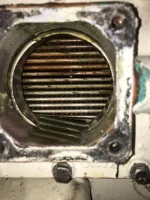MikeP
Legendary Member
- Joined
- Apr 12, 2005
- Messages
- 8,674
- Status
- OTHER
- Hatteras Model
- Not Currently A Hatteras Owner
As many of you know, I have never been a fan of in-place HE cleaning, preferring to pull the HEs and boil them per DD. However, I would like to try the in-place. Im looking at the plumbing, trying to see the most effective way to do this as far as "tapping into" the RW cooling system. I want to be able to flush opposite to the normal flow and to flush through the HE and then the fuel cooler and then the intercooler. Does anyone that uses the in-place method have a good description or pics of what they do?
Since we just did a WOT run yesterday, doing the in place would give me a great opportunity to see how it works re cleaning. I know that boiling the HE/intercooler per DD will allow the boat to run at WOT for extended periods with no coolant temperature issues. And I know that at present, the HE condition will NOT allow that. So this would be a perfect opportunity to try it out and evaluate.
Since we just did a WOT run yesterday, doing the in place would give me a great opportunity to see how it works re cleaning. I know that boiling the HE/intercooler per DD will allow the boat to run at WOT for extended periods with no coolant temperature issues. And I know that at present, the HE condition will NOT allow that. So this would be a perfect opportunity to try it out and evaluate.



